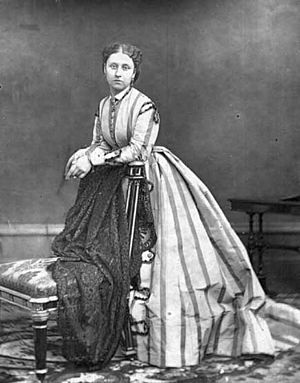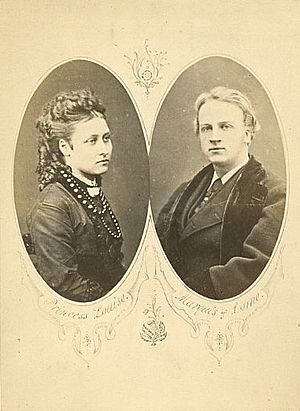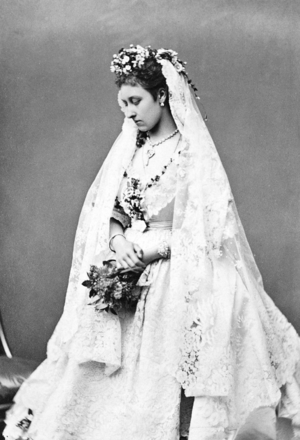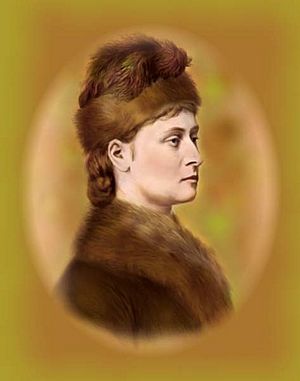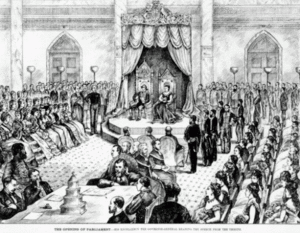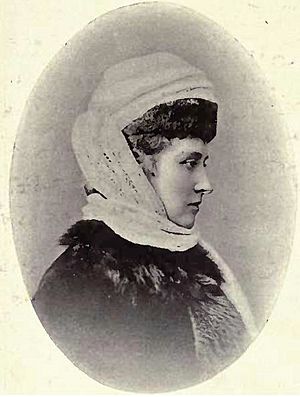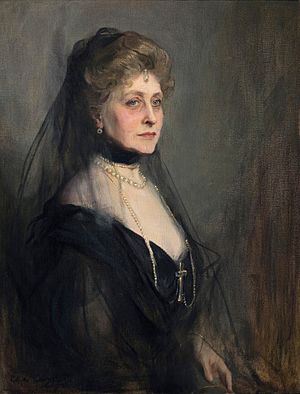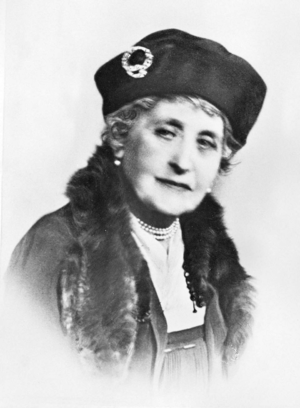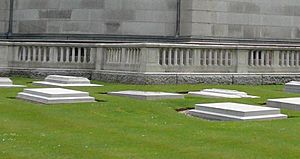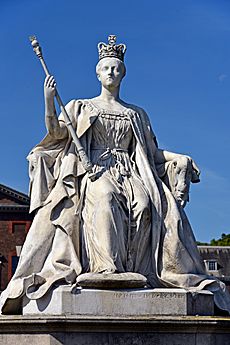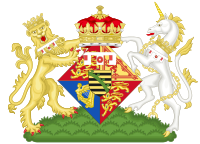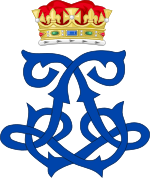Princess Louise, Duchess of Argyll facts for kids
Quick facts for kids Princess Louise |
|||||
|---|---|---|---|---|---|
| Duchess of Argyll | |||||
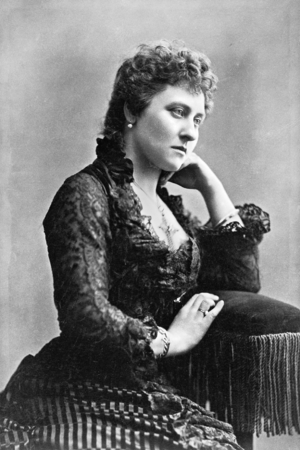
Princess Louise in 1881
|
|||||
| Born | 18 March 1848 Buckingham Palace, London |
||||
| Died | 3 December 1939 (aged 91) Kensington Palace, London |
||||
| Burial | 12 December 1939 Royal Vault, St George's Chapel, Windsor Castle 13 March 1940 Royal Burial Ground, Frogmore |
||||
| Spouse | |||||
|
|||||
| House | Saxe-Coburg and Gotha (until 1917) Windsor (from 1917) |
||||
| Father | Prince Albert of Saxe-Coburg and Gotha | ||||
| Mother | Queen Victoria of the United Kingdom | ||||
| Signature |  |
||||
| Viceregal consort of Canada | |||||
| In role 25 November 1878 – 23 October 1883 |
|||||
| Monarch | Victoria | ||||
| Governor General | John Campbell, Marquess of Lorne | ||||
| Preceded by | Hariot Rowan-Hamilton | ||||
| Succeeded by | Lady Maud Hamilton | ||||
Princess Louise, Duchess of Argyll (Louisa Caroline Alberta; 18 March 1848 – 3 December 1939) was the sixth child of Queen Victoria and Prince Albert. She was their fourth daughter.
Louise was very interested in the arts and education. She also supported the idea of equal rights for women. She spent her early life moving between different royal homes with her family. When her father died in 1861, the royal court went into a long period of sadness. Louise did not like this constant mourning. She was a skilled sculptor and artist, and some of her artworks can still be seen today.
Before she got married, Louise worked as an unofficial helper for her mother, Queen Victoria. She helped from 1866 to 1871. When it was time for Louise to marry, many princes from other countries were suggested. But Queen Victoria wanted her to marry someone important from Britain. Louise fell in love with John Campbell, Marquess of Lorne. He was the son of the Duke of Argyll. Even though some royal family members disagreed, Queen Victoria said yes to the marriage. They married on 21 March 1871.
In 1878, Lorne became the Governor General of Canada. This meant he was the Queen's representative there. Louise became the viceregal consort, which is like a partner to the Governor General. She developed a lasting interest in Canada. Many places in Canada are named after her, like Lake Louise and the province of Alberta. Louise and Lorne's marriage lasted, even with long times apart. They became closer again in 1911. Louise was very sad when Lorne died in 1914. After World War I, she slowly stopped doing public duties. She died at Kensington Palace when she was 91 years old.
Contents
Growing Up as a Princess
Louise was born on 18 March 1848 at Buckingham Palace in London. She was the sixth child of Queen Victoria and Prince Albert. Her birth happened during a time of revolutions across Europe. Queen Victoria joked that Louise would be "something peculiar." Louise's birth was the first time the Queen used chloroform to help with the pain.

Her parents chose the names Louisa Caroline Alberta. She was baptized on 13 May 1848 at Buckingham Palace. Even though her official name was Louisa, everyone called her Louise. Like her brothers and sisters, Louise was taught using a strict plan. This plan was made by her father, Prince Albert. The children learned practical skills like cooking, farming, and carpentry.
From a young age, Louise was very smart and artistic. Her talent was noticed quickly. A visitor to Osborne House in 1863 said that Louise could "draw beautifully." Because she was a princess, a career as an artist was not usually allowed. However, the Queen let her study art with a sculptor named Mary Thornycroft. Later, in 1863, she studied at the National Art Training School, which is now The Royal College of Art. Louise was also a good dancer. The Queen once wrote that Louise "danced the sword dance with more energy and skill than any of her sisters." Her cleverness and curiosity made her a favorite of her father. Other family members called her "Little Miss Why."
Life as the Queen's Secretary
Louise's father, Prince Albert, died on 14 December 1861. The Queen was heartbroken. The royal court became very sad after his death. Louise quickly became tired of her mother's long period of mourning. For her seventeenth birthday in 1865, Louise asked for a dance party. This kind of party had not happened since her father died. Her request was turned down. Louise found the royal routine boring. This annoyed her mother, who thought Louise was too outspoken.
The Queen continued with Prince Albert's plans for their children. Louise's older sister, Helena, got married. After Helena's marriage in 1866, Louise became the Queen's unofficial secretary. The Queen was worried Louise might be too outspoken for the job.
But Louise was good at it. Queen Victoria soon wrote that Louise was "a clever dear girl with a fine strong character." Louise's duties included writing letters for the Queen and helping with political messages. She also kept the Queen company. Louise also did public and charity work. For example, she opened the new North Eastern Hospital for Children in 1867. She also launched the ship HMS Druid in 1869.
Marriage and Family Life
Finding a Husband
As a daughter of the Queen, Louise was a popular choice for marriage. Many people thought she was the Queen's most beautiful daughter. However, she was sometimes unfairly accused of having romantic relationships. This, along with her modern ideas, made the Queen want to find her a husband. The Queen wanted Louise's husband to live close by.
Many princes from Europe were suggested. Princess Alexandra suggested her brother, the Crown Prince of Denmark. But the Queen did not want another marriage to a Danish prince. Louise's oldest sister, Victoria, suggested Prince Albert of Prussia. But Queen Victoria did not like this idea either. Prince Albert also did not want to live in England.
Louise did not want to marry just any prince. She said she wanted to marry John Campbell, the Marquess of Lorne. He was the son of the Duke of Argyll. It was very unusual for a monarch's daughter to marry a British subject. The last time this happened was in 1515. Louise's oldest brother, the Prince of Wales, strongly disagreed with this marriage. Lorne's father was also a strong supporter of a politician named William Ewart Gladstone. The Prince of Wales worried this would bring the royal family into political arguments.
But the Queen believed that Louise marrying a British subject would bring "new blood" into the family. She thought this would make the royal family stronger.
Engagement and Wedding
Louise and the Marquess of Lorne got engaged on 3 October 1870. This happened while they were visiting Balmoral Castle in Scotland. Lorne was invited to Balmoral. One day, Louise returned and told the Queen that Lorne had "spoken of his devotion" to her. She accepted his proposal, knowing the Queen approved.
The Queen found it hard to let her daughter go. She wrote in her diary that she "felt painfully the thought of losing her." This new type of royal marriage surprised many, especially in Germany. Queen Victoria wrote to the Queen of Prussia that German princes were "very unpopular" in Britain. She said Lord Lorne was "a person of distinction at home" and "really no lower in rank than minor German Royalty."
The wedding took place at St George's Chapel at Windsor Castle on 21 March 1871. Many people gathered outside. Louise wore a wedding veil she designed herself. Her mother and two oldest brothers walked her into the chapel. After the ceremony, the Queen kissed Louise. Lorne, who was now part of the royal family but still a subject, kissed the Queen's hand.
The couple went to Claremont in Surrey for their honeymoon. But they had attendants with them, so they could not talk privately. The Queen even interrupted their short four-day visit. She was curious about her daughter's thoughts on married life. One of their wedding gifts was a maplewood desk from Queen Victoria.
After her marriage, Louise continued her charity and art work. In 1871, she became president of the Ladies Work Society. This group helped poor people by selling needlework.
Life in Canada
In 1878, Benjamin Disraeli, the British Prime Minister, suggested Lorne become Canada's Governor General. Queen Victoria agreed. So, Louise became his viceregal consort.
As viceregal consort, she used her position to support the arts and education. She also supported equal rights for women. However, her time in Canada was not always happy. She missed home and did not like Ottawa much. She also had a bad sleighing accident.
Arriving in Canada
On 15 November 1878, Louise and Lorne left Liverpool. They arrived in Canada for the inauguration ceremony in Halifax on 25 November.
Louise was the first royal to live at Rideau Hall in Ottawa. This was the Queen's official residence in Canada. But the hall was not as grand as British royal homes. Each viceregal couple decorated the hall with their own furniture. When they left, they took their furniture with them. So, Louise and Lorne found the palace quite empty when they arrived. Louise used her artistic skills to decorate. She hung her watercolor and oil paintings and placed her sculptures around the hall.
At first, Canadians were excited that a princess would be their viceregal consort. They felt it would connect them strongly to their Queen. But the Canadian newspapers were not happy at first. They complained about having royalty in their country.
Relations with the press got worse when Lorne's private secretary, Francis de Winton, removed four journalists from the royal train. Louise and Lorne did not know about this. But the press assumed they did. This gave them a reputation for being proud. Louise was upset by the negative news. She said she "wouldn't care if they came in blanket coats!" This was a reference to a common Canadian coat. Eventually, people realized that the royal couple were more relaxed than previous governors.
Canadian Activities
Louise's first few months in Canada were sad. Her favorite sister, Alice, died on 14 December 1878. She missed home during that first Christmas. But Louise soon got used to the cold winter. Sleighing and skating became her favorite activities. In Canada, Lorne, as the Queen's representative, always had higher rank than Louise. So, at the Opening of the Parliament of Canada in 1879, Louise was treated like other guests. She had to stand with the Members of Parliament until Lorne asked everyone to sit.
Lorne held dinners for 50 people twice a week to meet every Canadian Member of Parliament. Some Canadian ladies did not like the British guests. One of Louise's helpers said some had an "I'm as good as you" attitude. Court parties were open to anyone who could afford the right clothes. They just had to sign the visitor's book. Louise's first big ball was on 19 February 1879. She made a good impression when she ordered the silk rope separating the royal party from the guests to be removed. However, some guests complained about the social status of other attendees. One person was shocked to see their grocer dancing at the same party.
One of Louise's sculptures is a statue of Queen Victoria. It now stands in front of the Royal Victoria College in Montreal. Lorne's father, the Duke of Argyll, visited in June. While he was there, Louise caught a 28-pound (13 kg) salmon. The Duke joked that fishing in Canada did not require much skill.
Sleigh Accident and Bermuda Visit

Louise, Lorne, and two helpers were in a sleigh accident on 14 February 1880. The winter was very harsh. Their carriage overturned, throwing the driver and footman out. The horses then panicked and dragged the overturned carriage for over 400 yards (370 m). Louise was knocked out when her head hit an iron bar. Lorne was trapped under her. Eventually, the horses calmed down. Louise's aide-de-camp ordered another carriage to take them back to Rideau Hall.
Doctors said Louise had a bad concussion and was in shock. They said it was amazing her skull was not broken. Her ear was also torn when her earring caught on the sleigh. Lorne's private secretary told the press to play down the story. This was a bad idea. For example, one newspaper said, "Excepting immediately after the blow, the princess was perfectly sensible during the whole time..." If people knew how badly Louise was hurt, they might have felt more sympathy. Instead, when Louise canceled her events, people thought she was pretending to be sick. News of the accident was also played down in Britain. Princess Louise left Canada for England in 1881. Her husband stayed in Canada until 1883.
She helped develop tourism in Bermuda. In 1883, because of her health, she spent the winter there. She arrived on 29 January 1883. Her visit made Bermuda popular for rich North Americans wanting to escape cold winters. A grand hotel, opened in 1885, was named after her: the Princess Hotel.
Continuing Interest in Canada
After returning to Britain in 1883, Louise remained interested in Canada. During the North-West Rebellion of 1885, she sent medical supplies and money to help. She said the help should go to everyone, both friends and enemies.
In 1905, the province of Alberta was named after Princess Louise Caroline Alberta. She wanted to honor her father, so her last given name was chosen. Lake Louise and Mount Alberta are also named after her. Even though her time in Canada was not always easy, she liked the Canadian people. She kept strong ties with her Canadian regiments.
Later Years
Family Life and Public Duties
Louise returned to Britain with her husband on 27 October 1883. Queen Victoria gave them apartments at Kensington Palace. This remained Louise's home for the rest of her life.
Louise started her public duties in Britain again. For example, she opened St George's Gardens in Bloomsbury in 1884. Lorne continued his political career. He became a Member of Parliament in 1896. Louise supported Irish Home Rule, which was different from Lorne's views. This caused some tension between them. Louise and Lorne's relationship was sometimes difficult. They often spent time apart.
Louise's relationship with her sisters, Beatrice and Helena, was not always easy. Beatrice married Prince Henry of Battenberg in 1885. Louise, who could be jealous, had been used to feeling sorry for Beatrice because the Queen needed her so much. After Prince Henry died in 1896, Louise wrote that he was "almost the greatest friend I had."
An Unconventional Royal
Louise wanted to be seen as an ordinary person, not just a royal. When she traveled abroad, she often used the name "Mrs Campbell." Louise was known for being kind to her servants. Once, a butler wanted to fire a footman who was always late. Louise suggested giving him an alarm clock. When that did not work, she suggested he might be sick. It turned out he had tuberculosis. The footman was sent to New Zealand to get better.
Another time, when she visited Bermuda, she chose to walk to a party instead of being driven. She stopped at a house for a glass of water. A woman named Mrs McCarthy lived there. Water was scarce, so the woman had to go a distance to get it. She was also busy ironing. Louise offered to help with the ironing. The woman refused, saying she was in a hurry to finish so she could see Princess Louise. Louise realized she had not been recognized. She asked if Mrs McCarthy would recognize her again. The woman said she thought so, but was not sure. Louise replied: "Well take a good look at me now, so you can be sure to know me tomorrow at St. Georges." The princess liked her privacy and enjoyed not being recognized.
Louise and her sisters had another disagreement after the Queen's friend died. Louise wanted the news to be told to the Queen slowly. When this did not happen, Louise criticized Helena and Beatrice. One month later, on 22 January 1901, Queen Victoria died. In her will, the Queen left Kent House to Louise as a country home. She gave Osborne Cottage to Louise's youngest sister, Beatrice. Louise and Beatrice became neighbors at both Kensington Palace and Osborne.
Final Years
After Queen Victoria died, Louise joined the social group of her brother, the new King Edward VII. They had a lot in common, including smoking. Louise was very focused on being physically fit. If someone made fun of her for it, she would say, "Never mind, I'll outlive you all." Meanwhile, Louise's husband, who became the 9th Duke of Argyll in 1900, took his seat in the House of Lords.
Louise spent much of her time at Kent House. She often visited Scotland with her husband. Money was still a concern even after Lorne became Duke. Louise avoided inviting the King to Inveraray, the Argyll family home, because they were trying to save money. When Queen Victoria had visited the house before, there were many servants and dogs. By the time Edward VII became King, there were only a few.
The Duke of Argyll's health got worse. He became more forgetful. Louise took care of him from 1911. During these years, Louise and her husband were closer than before. In spring 1914, Louise was at Kensington Palace while her husband was on the Isle of Wight. He got sick with breathing problems and then pneumonia. Louise was called on 28 April 1914, and he died on 2 May. After his death, Louise was very sad and felt very lonely.
Louise spent her last years at Kensington Palace, living next to her sister Princess Beatrice. She sometimes appeared in public with the royal family. For example, she was at the Cenotaph in Whitehall in 1925. But her health got worse. In 1935, she greeted her nephew, King George V, and his wife, Queen Mary, during their Silver Jubilee. She was made an Honorary Freeman of Kensington. Her last public appearance was in 1937. Between these events, her great-nephew, King Edward VIII, gave up his throne in 1936. Louise wrote to the British Prime Minister, Stanley Baldwin, showing her support during this time.
After Edward's brother King George VI became King, Louise became too ill to move much. She stayed at Kensington Palace. Princess Elizabeth (who would become Elizabeth II) and Princess Margaret lovingly called it the "Auntie Palace." Louise had nerve pain in her arm and ribs, and fainting spells. She kept busy by writing prayers.
Death and Legacy
Princess Louise died at Kensington Palace on 3 December 1939. She was 91 years old. She was wearing the wedding veil she had worn almost 70 years earlier. Because of the war, her funeral was simple. Her body was cremated on 8 December 1939. Her ashes were placed in the Royal Vault at St. George's Chapel on 12 December 1939. Many members of the royal family and Argyll family were there. Her ashes were later moved to the Royal Burial Ground, Frogmore near Windsor on 13 March 1940. Louise's will said she wanted to be buried at Frogmore if she died in England. Her coffin was carried by soldiers from her own regiment. Her belongings were valued at about £239,260.
Louise has four Canadian regiments named after her: The Argyll and Sutherland Highlanders of Canada (Princess Louise's), the Princess Louise Dragoon Guards, the 8th Canadian Hussars (Princess Louise's), and the Princess Louise Fusiliers.
Queen Elizabeth II later remembered that Louise and her sister Beatrice would talk so much they would amaze their audience.
The province of Alberta in Canada is named after her. The name "Louise" was first planned, but the princess wanted to honor her father. So, the last of her given names, Alberta, was chosen. Lake Louise and Mount Alberta are also named after her. Even though her time in Canada was not always happy, she liked the Canadian people. She kept close ties with her Canadian regiments. Back home, she was known for making surprise visits to hospitals, especially in her later years.
Her relationship with her family was generally close. She sometimes argued with the Queen and her sisters Helena and Beatrice, but these disagreements did not last long. She wrote letters to her brother, Prince Arthur, throughout her life. She was one of King Edward VII's favorite sisters. She was closest to Prince Leopold and Princess Alice. Their deaths made her very sad.
Among the younger members of the family, Louise's favorite relatives were the Duke and Duchess of Kent. They were her grand-nephew and his wife. At the coronation of King George VI and Queen Elizabeth in 1937, Louise lent the Duchess the long train she designed and wore for the coronation of King Edward VII and Queen Alexandra in 1902.
A hospital in Erskine, Scotland, is named after Louise. It was originally called Princess Louise Scottish Hospital for Limbless Sailors and Soldiers. It is now called Erskine Hospital and is the largest charity for former service members in the country.
Princess Louise's Art
Louise had art training from childhood. She learned from different sculptors and artists. She also attended the National Art Training School. Like many women artists in her time, Louise had to train in ways meant for industrial designers, not fine artists.
Louise was the most artistic of Queen Victoria's daughters. She created many artworks and sculptures. When Louise sculpted a statue of the Queen in her coronation robes, some newspapers claimed her teacher, Sir Edgar Boehm, was the real artist. Louise's friends denied this, saying she did the work herself. This statue was meant to be shown in 1887 but was not finished until 1893. Other works include a memorial to her brother-in-law, Prince Henry of Battenberg, and a memorial to soldiers who died in the Second Boer War. These are at Whippingham Church on the Isle of Wight. Another statue of Queen Victoria is at McGill University in Montreal. There is also a statue of Queen Victoria on the north side of Lichfield Cathedral.
Some of Her Artworks
Drawings
- Queen Victoria, 1881. Pencil on paper. Royal Collection Trust.
Sculptures
- Princess Beatrice, 1864. Marble. Royal Collection Trust.
- Prince Arthur, 1869. Marble. Royal Collection Trust.
- Prince Leopold, 1869. Marble. Royal Collection Trust.
- Queen Victoria, 1887. Bronze. Leeds Museums and Galleries.
- Self Portrait, date unknown. Terracotta. National Portrait Gallery, London.
- Memorial to Mary Ann Thurston, a listed monument in Kensal Green Cemetery. Thurston was a nanny to Queen Victoria's children.
- Memorial to the Colonial Forces of the Second Boer War, put up in 1905 at St Paul's Cathedral, London.
Titles, Styles, and Honors
Titles and How She Was Addressed
- 18 March 1848 – 21 March 1871: Her Royal Highness The Princess Louise
- 21 March 1871 – 24 April 1900: Her Royal Highness The Princess Louise, Marchioness of Lorne
- 24 April 1900 – 3 December 1939: Her Royal Highness The Princess Louise, Duchess of Argyll
Honors She Received
- British Honors
- 21 January 1865: Lady of the Royal Order of Victoria and Albert (first class)
- 1 January 1878: Companion of the Order of the Crown of India
- 7 August 1885: Member of the Royal Red Cross
- 10 February 1904: Royal Family Order of King Edward VII
- 3 June 1911: Royal Family Order of King George V
- 3 June 1918: Dame Grand Cross of the Order of the British Empire
- 12 June 1926: Dame Grand Cross of the Venerable Order of St John
- 11 May 1937: Dame Grand Cross of the Royal Victorian Order
- Honors from Other Countries
Honorary Military Roles
 3 July 1911: Honorary Colonel, 5th Princess Louise Dragoon Guards (later 4th Princess Louise Dragoon Guards)
3 July 1911: Honorary Colonel, 5th Princess Louise Dragoon Guards (later 4th Princess Louise Dragoon Guards) 1913: Colonel-in-Chief, Kensington Regiment (Princess Louise's)
1913: Colonel-in-Chief, Kensington Regiment (Princess Louise's) 22 June 1914: Colonel-in-Chief, The Argyll and Sutherland Highlanders (Princess Louise's)
22 June 1914: Colonel-in-Chief, The Argyll and Sutherland Highlanders (Princess Louise's) 15 April 1930: Colonel-in-Chief, The Argyll and Sutherland Highlanders of Canada (Princess Louise's)
15 April 1930: Colonel-in-Chief, The Argyll and Sutherland Highlanders of Canada (Princess Louise's) 14 August 1936: Colonel-in-Chief, The Princess Louise Fusiliers
14 August 1936: Colonel-in-Chief, The Princess Louise Fusiliers
Honorary Positions
- President of the Women's Education Union from 1871
- Patron of the Girls' Day School Trust, 1872–1939
- Patron of the Ladies Lifeboat Guild, Royal National Lifeboat Institution, 1923–39
Coat of Arms
In 1858, Louise and her three younger sisters were allowed to use the royal arms. Their arms had a small shield of Saxony and a special design to show they were different. On Louise's arms, the outer points had red squares, and the middle point had a red rose. In 1917, the small Saxony shield was removed.
| Coat of arms (1858–1917) | Royal monogram |
See also
 In Spanish: Luisa del Reino Unido (1848-1939) para niños
In Spanish: Luisa del Reino Unido (1848-1939) para niños


